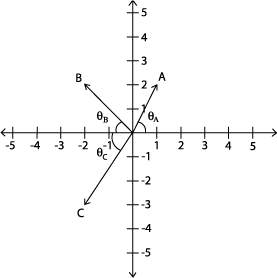|
|
|
|
| Solutions |
|
Q1: Draw a Cartesian coordinate system and label the x and y axis. On your coordinate system draw the following three vectors: A=1x+2y B=-2x+2y C= -2x+-3y Q2: Identify and plot three angles (a,b,c) to describe the direction of each vector.
Q3: Calculate the magnitude and angles of each vector. Mark these on the diagram.
Q4: Can the x or y component of a vector ever have a greater magnitude then the vector itself? Justify your answer in your own words. The components of a vector can never have a magnitude greater than the vector itself. This can be seen by using Pythagorean's Thereom. There is a situation where a component of a vector could have a magnitude that equals the magnitude of the vector. e.g. A=2x + 0y. Q5: Suppose two vectors have unequal magnitudes. Can their sum ever be zero? Justify your answer in your own words. No: Magnitude is always positive even if the direction is negative. For the sum of two vectors to equal zero the sum of their respective components must equal zero. For example:
the only way for this to happen is if ax = -bx and ay = -by, but if this were true then using Pythagorean's thereom, the magnitude of A and B would be the same positive value. |
|
|
|
|
